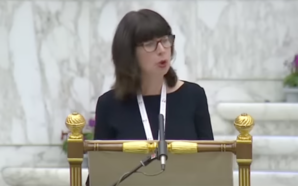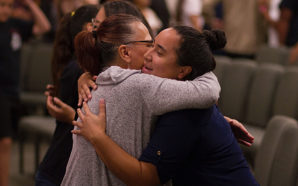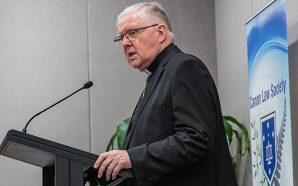The refusal to consider synodality as a key part of the Church’s response to the abuse crisis is a failure of ecclesial imagination, argues Massimo Faggioli
If you blinked, you probably missed it. But this past Sunday was the 150th anniversary of the opening of the First Vatican Council.
It was on Dec. 8, 1869 that Pope Pius IX convened the council that would come to be known for its declarations on papal primacy and infallibility. It would be the symbol of an assertive Catholicism that pushed back against liberal modernity.
Catholic missiologist Robert Schreiter has observed that Vatican I paved the way for a “period of certainty” within the Church.
From a period of certainly, to paralyzing uncertainty
But the sex abuse crisis has turned that assessment on its head and has shattered any such allusions of supposed certitude. Catholics are now questioning many assumptions about their past, including the meaning and effects of both Vatican I (1869-70) and Vatican II (1962-65).
How can Catholic doctrine, including its conciliar teaching, co-exist with what we’ve learned about the sexual abuse crisis – a phenomenon that clearly did not just begin in the 1960s?
Rather than a period of certainty, the Church is currently experiencing a period of paralyzing uncertainty, something much different from the liberating uncertainty that marked the initial years after the Second Vatican Council.
The continuing effects of the sex abuse crisis are actually conditioning the Church’s reception and/or rejection of key elements of Vatican II.
The crisis could become a line of demarcation – a before and an after – in the history of the reception and application of this most recent council.
We must seek to understand the relationship between the sexual abuse crisis and Vatican II – how such abuse and its pattern of cover-up were able to continue during the implementation and reception of the council.
The sobering fact is that the failure of the post-Vatican II period to tackle those horrific crimes is nothing new. If we look back to the council of Trent (1545-1563), we can see there was also a disconnect between its teaching on reform and how it was applied to the real life of the Church.
Lessons from the Tridentine Church
Studies on the Tridentine period verify that it was extremely rare for priests and religious accused of criminal acts (especially of sexual crimes) to face justice, either in ecclesiastical courts or the justice of the state.
Historians talk about a “negotiated justice” where many factors and different players intervened in shielding clerics.
In the period following Trent, the rise of papal diplomacy had an important role in protecting criminal clerics. Papal nuncios and delegates in diplomatic missions often defended the ordained from state tribunals, as well as from the efforts of local bishops to bring to justice members of their clergy.
Typical of that period was a fragmentation between different justice systems: the justice of the State, which had an interest in prosecuting those crimes, and the separated justice system that Catholic clergy were entitled to (the so-called privilegium fori).
But there was also fragmentation within the Church: the authority of the local bishops; the authority of the religious orders (exempt from the jurisdiction of the bishops); and the authority of Rome, which had an interest in maintaining good relations with the bishops, the religious and the states.
The papacy’s paramount concern was keeping the power of the State at bay and avoiding all possible secular interference in Church affairs.
This post-Trent history can help us better understand how today’s Church has faced the sex abuse crisis — not only in terms of fragmentation of jurisdictions, but also in the way the crisis is communicated to the public, including the Church’s own members.
In the 16th and 17th centuries, as in our own day, there was great concern not to disclose the reasons why a member of the clergy “resigned” his office. Such secrecy is, indeed, part of the Church’s legal tradition and strategy when dealing with crimes of the clergy, especially those of a sexual nature.
Within this tradition, the clergy were give special treatment when it came to their sentencing. Alternatives to jail (and torture) were widely available to convicted members of the clergy. Justice tended to be highly symbolic and not as harsh as that meted out for lay people who committed the same crimes.
There are also other similarities between the Tridentine period and today. Even the most inflexible enforcers of orthodoxy, Pius V (pope from 1566-72), was not willing to surrender clergy privileges when it came to shielding clerics from secular justice.
Moreover, in the centuries after Trent, it was deemed more important to wage the fight against heterodoxy than against criminal clergy. In a similar way, some contemporary Catholics continue to cast the abuse crisis as a product of the social and cultural upheaval of the 1960s and 1970s.
A cautionary tale
The failure of the Tridentine Church of the 16th and 17th centuries to fight against criminal clergy, including those guilty of sexual crimes, was also due to an intra-Catholic struggle for the supremacy between the papacy and its diplomats, the bishops, the religious orders, and lay Catholic elites.
By the 18th century the Church’s inability to deal with its criminal clergy led to secular authorities intervening more aggressively in its affairs.
This is a cautionary tale. Just as Trent’s failures led to the secular states’ aggressive “jurisdictionalism” three centuries ago, the current Church’s inability to implement the Vatican II ecclesiology of the People of God will likely lead to a new wave of state intervention in ecclesiastical affairs.
What we have seen up until now is just the beginning.
For the modern nation state, the safety of children and vulnerable people in religious institutions far outweighs any traditional deference to Church power. It has become a matter of public health and safety. The list of the recommendations issued by the Royal Commission to the Catholic Church in Australia is a very good example of that.
An ecclesiastical system that does not yet reflect Vatican II
In institutional terms, the Catholic Church today continues to resemble the Tridentine and post-Tridentine ecclesiastical system, rather than the one envisioned by Vatican II.
Nonetheless, there have been important changes. One is historical and concerns Church-State relations. In the former era, prosecution of the crimes of the clergy was perceived by both sides as a minor issue compared to the power struggle between them.
Another change is that, in the past, sexual crimes of the clergy only rarely elicited protests from the local communities and lay faithful. When there were protests, they were because the priest was not providing the people access to the sacred.
There was a sharp separation between the faithful’s expectations of how their priest performed his sacred functions and how the cleric conducted his private life.
Now, we live in an age where the Catholic faithful, and the entire world, expect leaders of the Church to be witnesses and not merely proclaimers of the Gospel. The line of separation between private and public has been all but eliminated.
In search of an ecclesiology of the People of God
But the biggest change from Trent to today concerns ecclesiology. Catholics have a theological idea about the Church that is no longer dominated by elites and hierarchies. Rather, it is situated in communion with the People of God.
This is an ecclesiological shift that could play a key role in the fight against sexual abuse and the abuse of power in the Church.
History tells us that it would be a mistake to blame the abuse crisis totally on the priesthood.
The impunity of the clergy was the bad fruit of an even worse idea – that the clergy was above secular law. But it was also because two hierarchies – one clerical, the other secular – co-conspired in corruption (political, social, and economic).
Synodality: essential to overcoming the abuse crisis
This is why Pope Francis’ emphasis onsynodality is so important. From the Roman Curia to the diocesan and parish system, the institutional structure of the Church in the current post-conciliar period is still quite Tridentine.
But Catholic ecclesiology of Vatican II is not.
Synodality is essential to overcoming the abuse crisis because – as Francis said in a major speech in October 2015 – it addresses the evil that “consigns the fate of entire peoples to the grasp of small but powerful groups.”
That papal speech on synodality marked a key moment in the history of the reception of Vatican II. And it should also mark a point of passage in how the Church must face the abuse crisis.
The best examples of that in global Catholicism today come from Churches that have started a local or national synodal process. In different ways and with different names, they have all included the articulation of specific policies to address the tragedy of sexual abuse.
The alternative is to passively standby, in shame and disgust, as the news cycles trumpet the sordid activities of this or that prelate and publish the latest devastating report by a grand jury or attorney general.
In the absence of a proper ecclesial way to react to the scandal, the new awareness raised about the sexual abuse crisis is destined to cause further loss of trust in the Church as a communion. Ultimately, it will lead to a massive abandonment of the faith.
The refusal to consider synodality as a key part of the Church’s response to the abuse crisis is a failure of ecclesial imagination. It is also a betrayal of the People of God.
By Massimo Faggioli. Reproduced with his permission and La Croix International.








